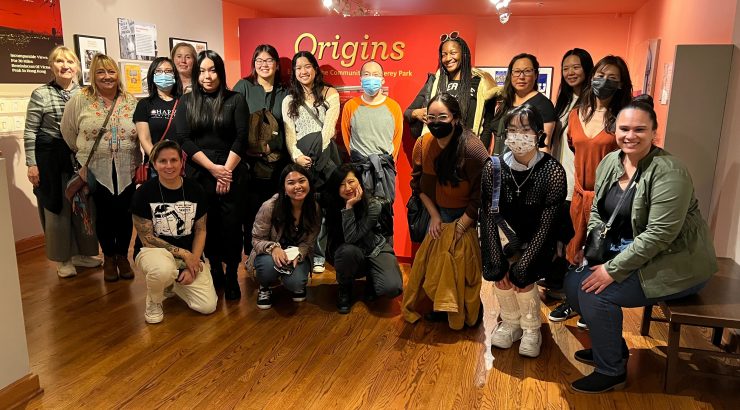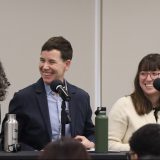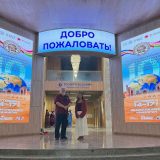
From Our Eyes Visiting the Chinese American Museum
February 17, 2023
For me, February 4, 2023 was quite a momentous day! It was my best friend, Winnie’s 21st birthday (she’s Chinese American!) It was civil rights activist Rosa Parks’s birthday, and it was also the day I got to visit the Chinese American Museum in Los Angeles with other Wilkinson College students, staff, and faculty.
The trip was organized by Associate Dean Stephanie Takaragawa, who recently received the largest National Endowment of the Humanities grant in Chapman University’s history to establish an Asian American minor. The minor will officially begin accepting students in Fall 2023. The grant included opportunities for experiential learning field trips, including our excursion to the Chinese American Museum. Last summer, another group toured the Japanese American National Museum, also in downtown LA.
As a Pinay immigrant, someone born and raised in the Philippines who is just at the beginning of my 5th year living in the United States, immigration histories and Asian American studies have always been deeply personal to me. My endeavors to understand my embodied experience as a Filipina migrant have led me to Wilkinson’s Interdisciplinary minors like Africana Studies, Ethnic Studies, and Women’s and Gender Studies. So, when I first heard about this opportunity through Wilkinson College, I was thrilled to recognize that the education I was receiving at Wilkinson is one grounded in valuing local histories and community stories. This trip to L.A. was an opportunity to learn about the meaningful histories of communities of color in the city and to bear witness to these multiple legacies of love and care that reach into our present moment.
When we got off the train at Union Station, we were energetically greeted by our guide. Much of the museum experience was extremely interactive. Our guide loved asking us questions and testing our knowledge as we went from room to room. We also got to see how these histories were intimately present for us, as our guide asked us about our own migration histories. They proceeded to connect it to immigration histories like the Chinese Exclusion Act as well as the Immigration Act of 1965. They also brought in various aspects of Chinese American history that are much lesser known, including the gendered aspects to this immigration history. For example, our guide told us how Chinese women had a much different immigration experience and also immigration timeline from Chinese men, because they were, in many ways, barred from coming into the United States for work opportunities like the railroad, because they weren’t seen as capable of providing labor.
There were difficult histories that were also confronted in this space. I had not known about the Los Angeles Chinese Massacre of 1871, where Chinese residents were viciously targeted. Our guide explained how, if you looked closely enough, you could find plaques around the city that noted this history, and there is an intent now by the city to build a monument. We also discovered how the museum (situated outside of present-day Chinatown) is actually located where the original Chinatown was. The building of the historic and beautiful Union Station came out of a violent history, as the train station was built over the original Chinatown, displacing and evicting many Chinatown residents.
At the same time, we got to see ingenious survival strategies and the persistence of community love and care. Throughout the years, Chinese communities in the area have continually carved out a space for their lives and for their community. In the early Chinatown, residents primarily had to depend on cultural tourism as an economic strategy because they were marginalized from other employment opportunities. As the Chinese community advocated and organized and as this community grew with more immigrants able to come into the United States, new opportunities emerged. Chinese communities could move more freely, leading to the emergence of new community spaces. One such example, that we closed our tour on, is that of Monterey Park.
Having just heard about the lives that were claimed at Monterey Park on the eve of Lunar New Year, it felt especially meaningful and especially necessary to learn more about this community, this place, and their specific history of love and resistance. Residents here organized and advocated for one another. They fought against English-Only policies, established local diversity initiatives and produced community leaders like Lily Lee Chen, who in 1983, became the first Chinese American woman mayor in the continental United States and Judy Chu, the first Chinese American woman elected to Congress in 2009.
Undoubtedly, there was immense struggle and hardship, oppression and suffering, but there was also, all throughout this time, community resilience, hope, love and joy. To have stepped into this history that day was a powerful reminder for me, and I hope for everyone who reads this, of the possibilities realized in our present by those who collectively insisted on making a way when there was no way then.
Here is a beautiful reminder that more livable lives and more loving worlds are made possible everyday by our communities past and present and future.

